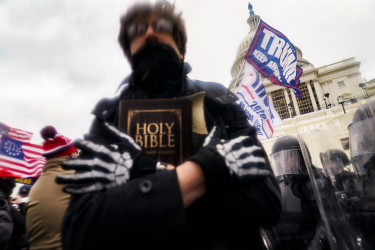Catching Sumner seated and unaware, Brooks thrashed him with dozens of blows to the head from his heavy cane, until the New England lawmaker lay bloody and unconscious on the senate floor. “Every lick went where I intended,” Brooks later bragged. “I plied him so rapidly that he did not touch me.” Violence among legislators, especially over the divisive slavery issue, was becoming increasingly commonplace by midcentury. Nevertheless, this brazen assault on Sumner inside the Capitol escalated tensions and transfixed the nation. In subsequent generations, other acts of violence would desecrate the building and alarm the country, but until the recent murderous assault by domestic terrorists, incited by a sitting U.S. president, the Caning remained the most notorious act of violence in congressional history.
Using the hurried newspaper accounts, several artists quickly filled the visual void by composing lithographs of the event. Most famously, John L. Magee, a New Yorker working in Philadelphia, drew a dramatic portrayal that has provided a startling illustration for textbooks ever since. Magee gave his picture the ironic and poorly-punctuated title, “Southern Chivalry – Argument versus Club’s,” and he featured recognizable details from the press, including Sumner’s overturned desk and the glaring head wounds that would keep him from fulfilling his senatorial duties for several years.
Another illustration is less well-known. Winslow Homer, one of Sumner’s Massachusetts constituents, was an aspiring illustrator completing a dull apprenticeship in a Boston lithography firm. Homer later made a name for himself as a wartime illustrator contributing to Harper’s Weekly, and he went on to become one of the country’s most admired painters. But at age 20, the young New Englander recreated the moment of the assault, calling his picture “Arguments of the Chivalry.” He had reason to feel stirred personally by the violent attack upon his home-state senator, and he may also have felt challenged by catching a glimpse of Magee’s portrayal. Or perhaps he simply received instructions from a supervisor or client interested in responding to the public clamor.
Like Magee, Homer worked the popular term “Chivalry” into his title. (Its contradictory meanings seemed clear enough without inserting “so-called,” in much the way that a modern caption-writer might use the word “Patriot” beneath a picture of Capitol marauders, knowing that most viewers would infer the obvious irony.) Predictably, Homer emphasized the assailants’ canes and high hats, familiar emblems of the southern gentry.
The rendition by the young Boston artist underscored the contrast between building a rational argument—speaking forcefully with a pen to craft a convincing argument—and abandoning reason to win one’s case through a resort to physical violence. Homer even emblazoned across the top of his picture a remark made by the Reverend Henry Ward Beecher a week after the event. The anti-slavery minister, speaking out in defense of Sumner, had proclaimed: “The symbol of the North is the pen; the symbol of the South is the bludgeon.”

























